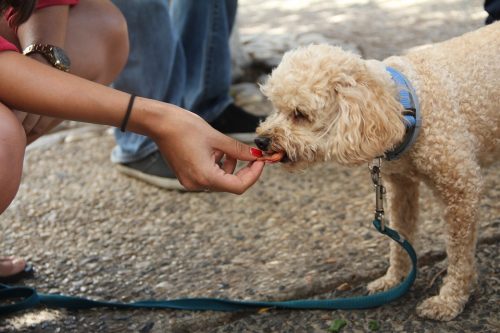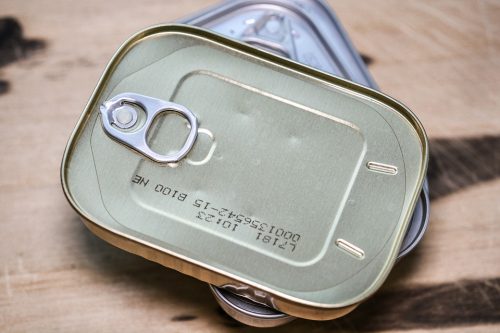Fish is an essential component of a diet because it is high in omega-3 fatty acids and protein. However, many pet owners are afraid of unexpected side effects or putting their pet’s health at risk. Can dogs eat tuna? Our experts will help you understand the risks and the nutritional benefits of tuna to your dogs below.
Can Dogs Really Eat Tuna?
Our team of experts’ short answer to this question – “can dogs eat tuna?” is yes. Dogs can safely eat tuna fish as it makes a healthy addition to the dogs’ diet. However, tuna shouldn’t become a staple dog food, and you shouldn’t feed tuna to your dog regularly or in large amounts.
Health Benefits of Tuna
Tuna fish offers several benefits for dogs since it is low in saturated fats, which would reduce the risk of obesity and other health problems. According to our experts, it is also a good source of lean protein in a dog’s diet.
Tuna is suitable for any furry canine with a sensitive stomach that doesn’t digest poultry protein well. Tuna fish enables dogs with particular food sensitivities to get the nutrients they need without having an upset stomach. In addition, the lean protein in tuna helps dogs to build healthy muscle.

Tuna is rich in potassium and magnesium. Both minerals are essential in a dog’s diet for healthy cells and muscles. It is also high in phosphorus, which is necessary for bone strength, and selenium, which is excellent for your dog’s health and immune systems. Tuna contains antioxidants, which help in reducing the actions of free radicals in your dog’s body.
Tuna is also rich in vitamins B2, B3, B6, B12, Dand, all of which support good energy levels and healthy metabolism. In addition, it contains omega-3 fatty acids, which will give your dog a healthy and shiny coat, reduce inflammation, boost cardiovascular health, and lower cholesterol levels.
Health Risks
Is tuna safe? Unfortunately, the increase in industrial activities has resulted in mercury pollution in the sea. As a result, fish with longer lifespans like tuna are at the risk of having accumulated levels of mercury. Tuna fish is also large and often feed on smaller fish that can have traces of mercury.
Feeding dogs tuna should be done moderately and with great care to prevent mercury poisoning, and ideally, you shouldn’t let your dogs eat raw tuna or raw fish, which might have elevated mercury levels.

Feeding your dog too much tuna would cause too much mercury to build up over time, which may result in mercury poisoning, resulting in severe, long-term, and potentially fatal health complications. Therefore, you may want to consider carefully before giving your pet tuna regularly as they can often get all the nutrients they need from kibble or canned food.
Is tuna bad for dogs? The answer is no. Tuna is not bad but must be served in small amounts.
Advisable Amount For Dogs
How much tuna can dogs eat? Our experts recommend that you give tuna to your dog as an occasional treat and not as a portion of regular daily dog food. Typically, it’s safe to provide one or two small pieces of tuna once or twice a week.
However, the size and weight of your dog also matter. While your small dog should be given less, your large dog can be given a little more, as their weight largely dictates how much they can consume.

If you feed your dog with canned or cooked tuna, it’s advisable to provide a 20 lbs dog with a standard can of tuna once every three weeks. A 40 lbs dog can have a can of tuna once every nine days, and a 90 lbs dog can be fed with a can of tuna once every five days without any harm.
Raw, Cooked, or Canned Tuna
Tuna is safe for your dog in small amounts and as a rare treat, but you may also want to know what choice of tuna a dog can eat.
It’s advised not to serve your raw dog tuna. It is not the safest choice as our experts’ opinion is that dog raw tuna contains too much mercury. Therefore, feeding your dog tuna can result in a higher risk of mercury poisoning and health complications.
Another reason why you shouldn’t feed fresh tuna to your dog because fresh tuna – like any other raw fish – may contain parasites and harmful enzymes like thiaminase. Thiaminase will render any thiamin (vitamin B1) that your dog ingests inactive.

Another downside of raw tuna fish is that it may have sharp bones that may injure your dog’s mouths or throat. In addition, tuna is a saltwater fish and might be rich in sodium chloride. That means fresh tuna may have too high sodium concentrations. The accumulation of sodium in a dog can cause hypernatremia (sodium poisoning).
Cooked tuna is the safest of all. Although the cooking process wouldn’t necessarily lower the mercury levels in tuna, it will destroy the thiaminase enzyme and other harmful parasites in tuna killed by heat. Cooking would also reduce the sodium chloride levels in tuna. If you decide to give tuna to your dog, ensure that it’s either the skipjack or albacore tuna and is adequately cooked and deboned.
Can dogs eat canned tuna? Yes, as long as you properly feed them with a can of tuna packed in freshwater rather than oil and don’t have added salt, seasonings, and spices. Irrespective of the form of tuna you’re giving, give tuna to your dog a little at a time and see how your dog reacts.
Tuna Meals You Can Feed Your Dog
Generally, dog owners can feed their canine companions with any of the tuna meals that they eat. However, they have to take note of the species of tuna fish used for the meal. There are about 29 different tuna species with different sizes and lifespans, which have a considerable impact on the mercury levels in their body.

Only about five of these 29 tuna species are safe for human consumption – skipjack, albacore, bluefin, bigeye, and yellowfin [1]. However, these five species are also used in dog foods as they are considered safe for dog consumption. Hence, eating tuna meals made with any of these “safe” Tuna species is safe for your dog.
However, if you want to make dog treats out of the tuna meal, our experts have a recipe below:
Tuna Treat Recipe
Ingredients:
- 1 can of tuna in water
- 1 can of salmon
- 4 eggs
- 1 cup of wheat flour

Open the two cans and pour the content into a bowl. Break and add the four eggs and then the cup of wheat flour. Mix all four ingredients until a smooth blend is reached. Pour the mixture into a baking pan and bake it in an oven for 40mins at 350°F. This will give you a golden brown dog meal.
Health Precautions
Here are some health precautions you can follow when giving tuna to your dog. First, only give your dog tuna occasionally (every once in a while) and in small amounts. For instance, give small, controlled pieces of tuna only once or twice a week, even if you think it’s among the world’s healthiest foods.
You should also consider the type of tuna you give your dog if you want to let a dog eat tuna. Smaller tuna, such as albacore and skipjack tuna, is better than larger tuna fish species like bluefin and yellowfin.

Some fresh fish such as arctic char offers the same nutritional benefits as tuna but have a low risk of mercury poisoning.
Dog Allergies
Just as with any other commercial dog food, there is a tendency that your dog may develop allergies or intolerances to tuna. Some of these allergies may lead to anxiety or nervousness, hair loss, loss of feeling in the paw, tremor, loss of coordination, and so on.
If you notice that your canine companion is allergic to tuna, do not feed your dog tuna fish. However, if your allergic dog feeds on tuna accidentally, visit the nearest vet immediately.
Puppies and Older Dogs
For puppies, we wouldn’t recommend giving any tuna as part of their diet. Puppies have developing digestive and gastrointestinal systems, and it’s best to avoid potential risks. Instead, try as much as possible to stick to commercial dog foods specialized for puppies or puppies’ complete formula during their first year of life.
Healthy older dogs can be fed with tuna without a problem. However, older dogs with health issues or sensitive stomachs shouldn’t be actively fed with tuna.
FAQ
How much tuna can I give my dog?
The amount of tuna you can give your dog largely depends on the size and weight of your dog. Typically, it’s safe to give your dog one or two small pieces of tuna one or two times a week. You can give your small dog a little bit less and your large dog a little bit more. Do not let your pup eat tuna, even if it’s just a little tuna.
Can tuna kill a dog?
No, tuna will not kill a dog. However, large amounts of tuna can lead to increased mercury levels, leading to a higher risk of mercury poisoning for your canine friend.
Which canned tuna is best for dogs?
Water-based canned tuna is the best option for dogs and not the oil-based option.
Is canned tuna healthy for dogs?
Yes, canned tuna is healthy for dogs as long as it’s a can of tuna packed in freshwater rather than oil or brine and doesn’t have seasonings and spices.
Conclusion
Can dogs eat tuna fish? Yes, dogs can eat tuna. Consuming a small amount of tuna will not cause mercury poisoning in dogs even if your dog eats the cat food you’ve laid out for your feline, which often contains tuna. However, you shouldn’t serve tuna to your canine companion regularly or in large amounts. A moderate amount is recommended when serving tuna to dogs.
